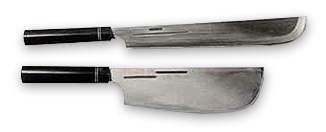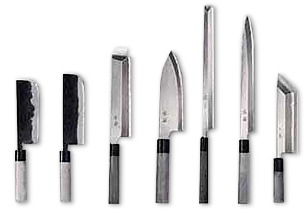The History of Japanese Kitchen Knife
First, I will tell you about the origin of the Japanese of a kitchen knife.
We describe a kitchen knife '庖丁’(Hocho) in Japanese, but Japanese people described it '庖丁’originally.
'庖’ means a kitchen, and '丁’ means a man, so '庖丁' shows a man in the kitchen that is a cook.
’庖丁’ doesn't mean all of cooks. ’庖丁’ is a proper noun of a great legendary cook who served the king at the time. He is introduced in Soushi (Soushi is a classic of Chinese).
It is a story about 2300 years ago.
’庖丁’ who was an expert of filleting, used the knife habitually, so people called the knife 庖丁- knife, and they started to call just '庖丁’, The dictionary says so.
However Chinese people don't call the kitchen knife '庖丁'. They call the knife for vegetable '菜切’, and the one which Japanese people call Chinese knife '菜刀’.
Therefor we can give a defintion of '庖丁', it is Japanese unique name of a knife which we use for cooking.
A Japanese book named Nihonsankaimeibutuzukan (It was writen in 1754) also says the origin of the name of a kitchen knife as follows.
Chuang-tzu said 庖丁 was a name of the cook originally.
People named the kitchen knife 庖丁, because the cook used it.
Some Japanese man read Chinese story about Chung-tzu, and then he named a kitchen knife 庖丁.
庖丁 become the name of kitchen knife now.
This was written in a section of Sakai-kitchen knife.
※Old Knives such as kitchen knives or carpenter tools except swords, it was destiny for them to be gone by polishing or using for a long time.
Therefore there are few old knives existed at present, so we can only know them in the old pictures such as picture scrolls or Ukiyoe.
Then we can only assume the structure or materials.
Japanese sword - style
Those names are kitchen knife, but the shape is similar Japanese sword without a hand guard.
The each total length is 38cm and 41cm.<See picture1>

<Picture1> Old Kitchen knives of Japanese sword-style at shousouin (Those ware made 1250 years ago).
Those are single edges, and made of steel. (The book named Shousouintennjiroksiryou says it made of iron.)
People used this kitchen knife for filleting fish mainly for 900 years until about ealy 1600s.
You can see Japanese sword-style knives in picture scroll,Ippenjyounineden written in 1299 or Bokiekotoba and Matuzakitenjinengi writen in the end of 14th century.
You can see kitchen knives in syuhannon written in the middle 16th cebtury,their tip was round and the blade width become wider, people used it for cutting vegetables.
It seems that this kitchen knife was a pioneer of wide-width kitcheb knife in 1690s.
Japanese sword-style Kitchen knife was draw in souoinbyoubuyurkuzu writen in the early 17th century, and also in kawagutiyurizubyoubu written in 1650s.
However, a shiki kitchen knife which had a chin replaced Japanese sword-style one after 1700s.
Shiki kitchen knife (It includes a wide-width kitchen knife)
As you see from Sharaku's pictures, people used this style one about 200 years during in 1850.<See picture2>

<Picture2>The Shiki style kitchen knife and wide-width kitchen knife made in 168,-1704. It is a middle style between old one and present one.
Today's Japanese Kitchen Knife
Yanagiba and an eel knife Edo style appeared in 1848-1859,and we are using them today.

<Picture3>It seems that today's main Japanese kitchen knives become their shape in 1800-1860.

